2023 NISSAN TITAN oil temperature
[x] Cancel search: oil temperaturePage 499 of 644

CAUTION
Be careful not to burn yourself, as the
engine oil is hot.
WARNING
• Prolonged and repeated contact
with used engine oil may cause skin
cancer.
• Try to avoid direct skin contact with
used oil. If skin contact is made, wash
thoroughly with soap or hand
cleaner as soon as possible.
• Keep used engine oil out of reach of
children.
4. Loosen the oil filter with an oil filter wrench by turning it counterclockwise.
Remove the oil filter by turning it by
hand.
5. Wipe the engine oil filter mounting sur- face with a clean rag.
CAUTION
Be sure to remove any old gasket ma-
terial remaining on the sealing surface
of the engine. Failure to do so could
lead to an oil leak and engine damage. •
The dipstick must be inserted in
place to prevent oil spillage from the
dipstick hole when filling the engine
with oil.
6. Coat the gasket on the new filter with clean engine oil.
7. Screw in the oil filter clockwise until a slight resistance is felt, then tighten addi-
tionally more than 2/3 turn.
Oil filter tightening torque: 11 to 15 f t-lb (15.0 to 21.0 N·m)
8. Clean and re-install the drain plug with a new washer. Securely tighten the drain
plug with a wrench. Do not use exces-
sive force.
Drain plug tightening torque: 22 to 29 f t-lb (29.4 to 39.2 N·m)
9. Refill the engine with the recommended oil through the oil filler opening, and in-
stall the oil filler cap securely.
For additional information about drain and
refill capacity, see “Recommended fluids/
lubricants and capacities” (P. 10-2). The
drain and refill capacity depends on the oil
temperature and drain time. Use these
specifications for reference only. Always use the dipstick to determine the proper
amount of oil in the engine.
10. Start the engine and check for leakage
around the drain plug and the oil filter.
Correct as required. Turn the engine off
and wait more than 15 minutes. Check
the oil level with the dipstick. Add en-
gine oil if necessary.
Af ter the operation
1. Reinstall plate in reverse order ofremoval.
2. Lower the vehicle carefully to the ground.
3. Reset oil and oil filter maintenance re- minder. For additional information, see
“Vehicle information display” (P. 2-24).
• Dispose of waste oil and filter properly.
• Check your local regulations.
Do-it-yourself8-13
Page 541 of 644
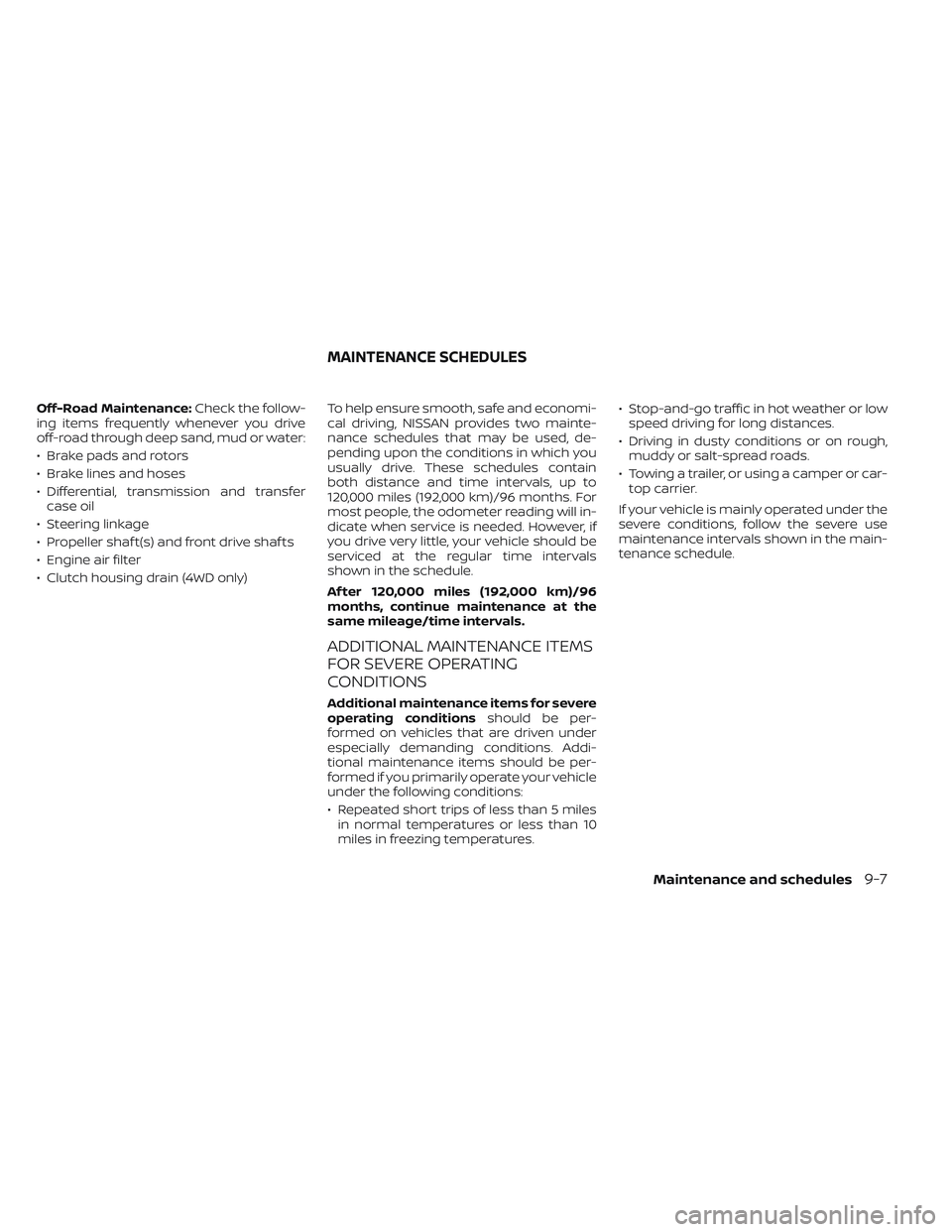
Off-Road Maintenance:Check the follow-
ing items frequently whenever you drive
off-road through deep sand, mud or water:
• Brake pads and rotors
• Brake lines and hoses
• Differential, transmission and transfer case oil
• Steering linkage
• Propeller shaf t(s) and front drive shaf ts
• Engine air filter
• Clutch housing drain (4WD only) To help ensure smooth, safe and economi-
cal driving, NISSAN provides two mainte-
nance schedules that may be used, de-
pending upon the conditions in which you
usually drive. These schedules contain
both distance and time intervals, up to
120,000 miles (192,000 km)/96 months. For
most people, the odometer reading will in-
dicate when service is needed. However, if
you drive very little, your vehicle should be
serviced at the regular time intervals
shown in the schedule.
Af ter 120,000 miles (192,000 km)/96
months, continue maintenance at the
same mileage/time intervals.
ADDITIONAL MAINTENANCE ITEMS
FOR SEVERE OPERATING
CONDITIONS
Additional maintenance items for severe
operating conditions
should be per-
formed on vehicles that are driven under
especially demanding conditions. Addi-
tional maintenance items should be per-
formed if you primarily operate your vehicle
under the following conditions:
• Repeated short trips of less than 5 miles in normal temperatures or less than 10
miles in freezing temperatures. • Stop-and-go traffic in hot weather or low
speed driving for long distances.
• Driving in dusty conditions or on rough, muddy or salt-spread roads.
• Towing a trailer, or using a camper or car- top carrier.
If your vehicle is mainly operated under the
severe conditions, follow the severe use
maintenance intervals shown in the main-
tenance schedule.
MAINTENANCE SCHEDULES
Maintenance and schedules9-7
Page 575 of 644
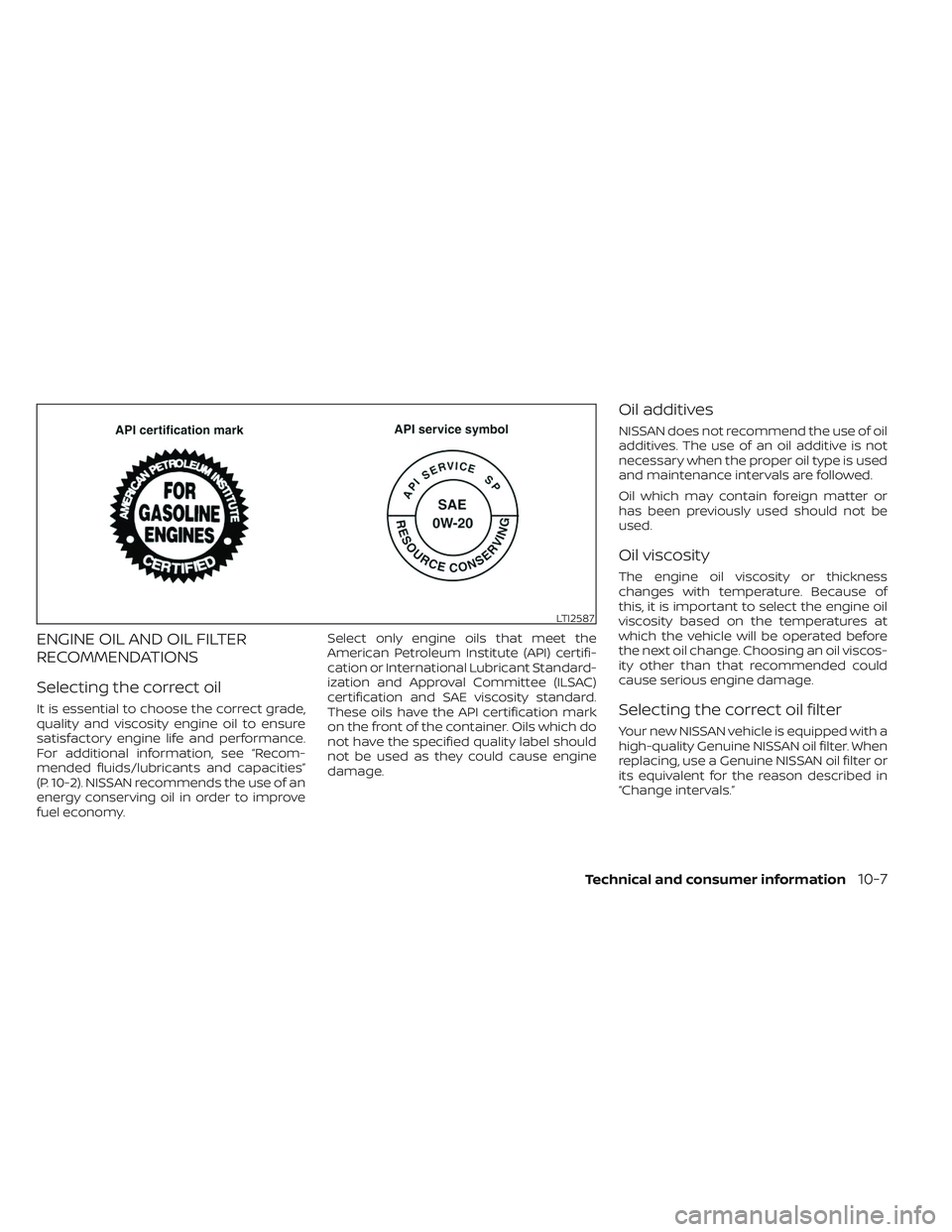
ENGINE OIL AND OIL FILTER
RECOMMENDATIONS
Selecting the correct oil
It is essential to choose the correct grade,
quality and viscosity engine oil to ensure
satisfactory engine life and performance.
For additional information, see “Recom-
mended fluids/lubricants and capacities”
(P. 10-2). NISSAN recommends the use of an
energy conserving oil in order to improve
fuel economy.Select only engine oils that meet the
American Petroleum Institute (API) certifi-
cation or International Lubricant Standard-
ization and Approval Committee (ILSAC)
certification and SAE viscosity standard.
These oils have the API certification mark
on the front of the container. Oils which do
not have the specified quality label should
not be used as they could cause engine
damage.
Oil additives
NISSAN does not recommend the use of oil
additives. The use of an oil additive is not
necessary when the proper oil type is used
and maintenance intervals are followed.
Oil which may contain foreign matter or
has been previously used should not be
used.
Oil viscosity
The engine oil viscosity or thickness
changes with temperature. Because of
this, it is important to select the engine oil
viscosity based on the temperatures at
which the vehicle will be operated before
the next oil change. Choosing an oil viscos-
ity other than that recommended could
cause serious engine damage.
Selecting the correct oil filter
Your new NISSAN vehicle is equipped with a
high-quality Genuine NISSAN oil filter. When
replacing, use a Genuine NISSAN oil filter or
its equivalent for the reason described in
“Change intervals.”
LTI2587
Technical and consumer information10-7
Page 576 of 644
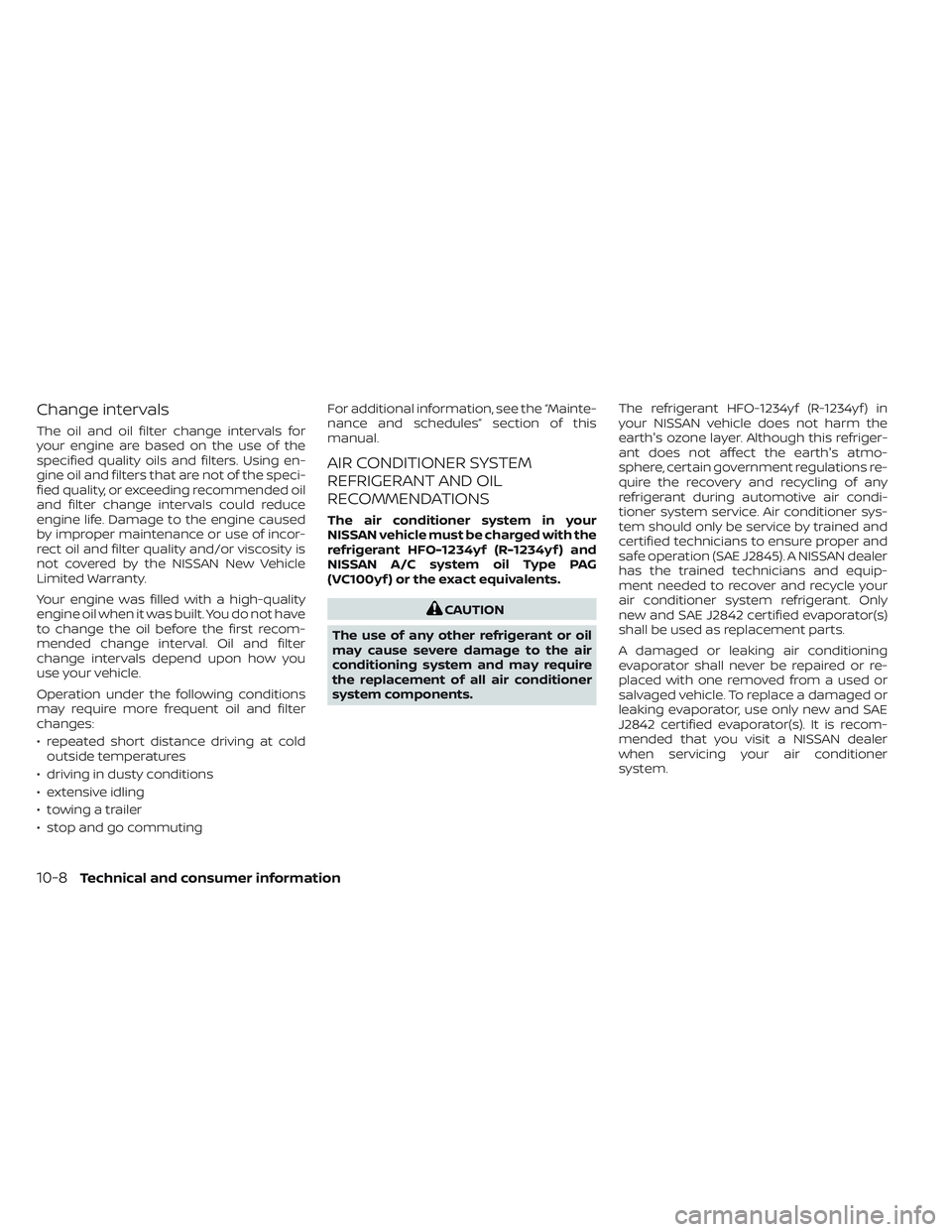
Change intervals
The oil and oil filter change intervals for
your engine are based on the use of the
specified quality oils and filters. Using en-
gine oil and filters that are not of the speci-
fied quality, or exceeding recommended oil
and filter change intervals could reduce
engine life. Damage to the engine caused
by improper maintenance or use of incor-
rect oil and filter quality and/or viscosity is
not covered by the NISSAN New Vehicle
Limited Warranty.
Your engine was filled with a high-quality
engine oil when it was built. You do not have
to change the oil before the first recom-
mended change interval. Oil and filter
change intervals depend upon how you
use your vehicle.
Operation under the following conditions
may require more frequent oil and filter
changes:
• repeated short distance driving at coldoutside temperatures
• driving in dusty conditions
• extensive idling
• towing a trailer
• stop and go commuting For additional information, see the “Mainte-
nance and schedules” section of this
manual.
AIR CONDITIONER SYSTEM
REFRIGERANT AND OIL
RECOMMENDATIONS
The air conditioner system in your
NISSAN vehicle must be charged with the
refrigerant HFO-1234yf (R-1234yf ) and
NISSAN A/C system oil Type PAG
(VC100yf ) or the exact equivalents.
CAUTION
The use of any other refrigerant or oil
may cause severe damage to the air
conditioning system and may require
the replacement of all air conditioner
system components. The refrigerant HFO-1234yf (R-1234yf ) in
your NISSAN vehicle does not harm the
earth's ozone layer. Although this refriger-
ant does not affect the earth's atmo-
sphere, certain government regulations re-
quire the recovery and recycling of any
refrigerant during automotive air condi-
tioner system service. Air conditioner sys-
tem should only be service by trained and
certified technicians to ensure proper and
safe operation (SAE J2845). A NISSAN dealer
has the trained technicians and equip-
ment needed to recover and recycle your
air conditioner system refrigerant. Only
new and SAE J2842 certified evaporator(s)
shall be used as replacement parts.
A damaged or leaking air conditioning
evaporator shall never be repaired or re-
placed with one removed from a used or
salvaged vehicle. To replace a damaged or
leaking evaporator, use only new and SAE
J2842 certified evaporator(s). It is recom-
mended that you visit a NISSAN dealer
when servicing your air conditioner
system.
10-8Technical and consumer information
Page 627 of 644
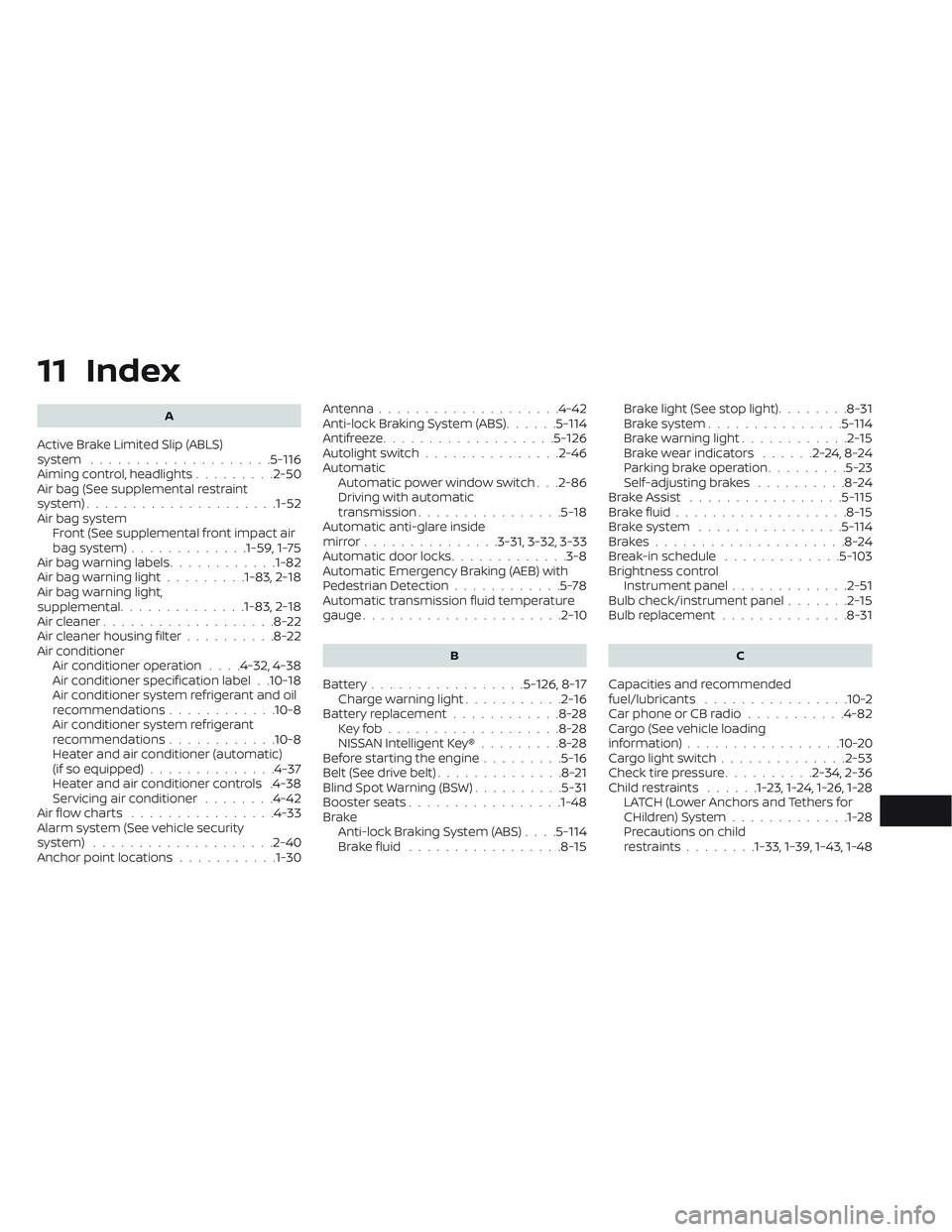
11 Index
A
Active Brake Limited Slip (ABLS)
system....................5-116Aiming control, headlights.........2-50Air bag (See supplemental restraint
system).....................1-52Air bag system
Front (See supplemental front impact air
bag system)
.............1-59, 1-75Air bag warning labels............1-82Air bag warning light.........1-83, 2-18Air bag warning light,
supplemental..............1-83, 2-18Air cleaner...................8-22Air cleaner housing filter..........8-22Air conditionerAir conditioner operation. . . .4-32, 4-38Air conditioner specification label. .10-18Air conditioner system refrigerant and oil
recommendations............10-8Air conditioner system refrigerant
recommendations............10-8Heater and air conditioner (automatic)
(if so equipped)..............4-37Heater and air conditioner controls.4-38Servicing air conditioner........4-42Air flow charts................4-33Alarm system (See vehicle security
system)................... .2-40Anchor point locations...........1-30
Antenna....................4-42Anti-lock Braking System (ABS)......5-114Antifreeze...................5-126Autolight switch...............2-46Automatic
Automatic power window switch. . .2-86Driving with automatic
transmission................5-18Automatic anti-glare inside
mirror...............3-31, 3-32, 3-33Automatic door locks.............3-8Automatic Emergency Braking (AEB) with
Pedestrian Detection............5-78Automatic transmission fluid temperature
gauge......................2-10
B
Battery.................5- 126, 8-17Charge warning light...........2-16Battery replacement............8-28Key fob...................8-28NISSAN Intelligent Key®.........8-28Before starting the engine.........5-16Belt (See drive belt)..............8-21Blind Spot Warning (BSW)..........5-31Booster seats.................1-48Brake
Anti-lock Braking System (ABS). . . .5-114Brake fluid.................8-15
Brake light (See stop light)........8-31Brake system...............5-114Brake warning light............2-15Brake wear indicators......2-24,8-24Parking brake operation.........5-23Self-adjusting brakes..........8-24Brake Assist.................5-115Brake fluid...................8-15Brake system................5-114Brakes.....................8-24Break-in schedule.............5-103Brightness controlInstrument panel.............2-51Bulb check/instrument panel.......2-15Bulb replacement..............8-31
C
Capacities and recommended
fuel/lubricants................10-2Car phone or CB radio...........4-82Cargo (See vehicle loading
information)................ .10-20Cargo light switch..............2-53Check tire pressure..........2-34, 2-36Child restraints......1-23,1-24,1-26,1-28LATCH (Lower Anchors and Tethers for
CHildren) System.............1-28Precautions on child
restraints........1-33, 1-39, 1-43, 1-48
Page 628 of 644
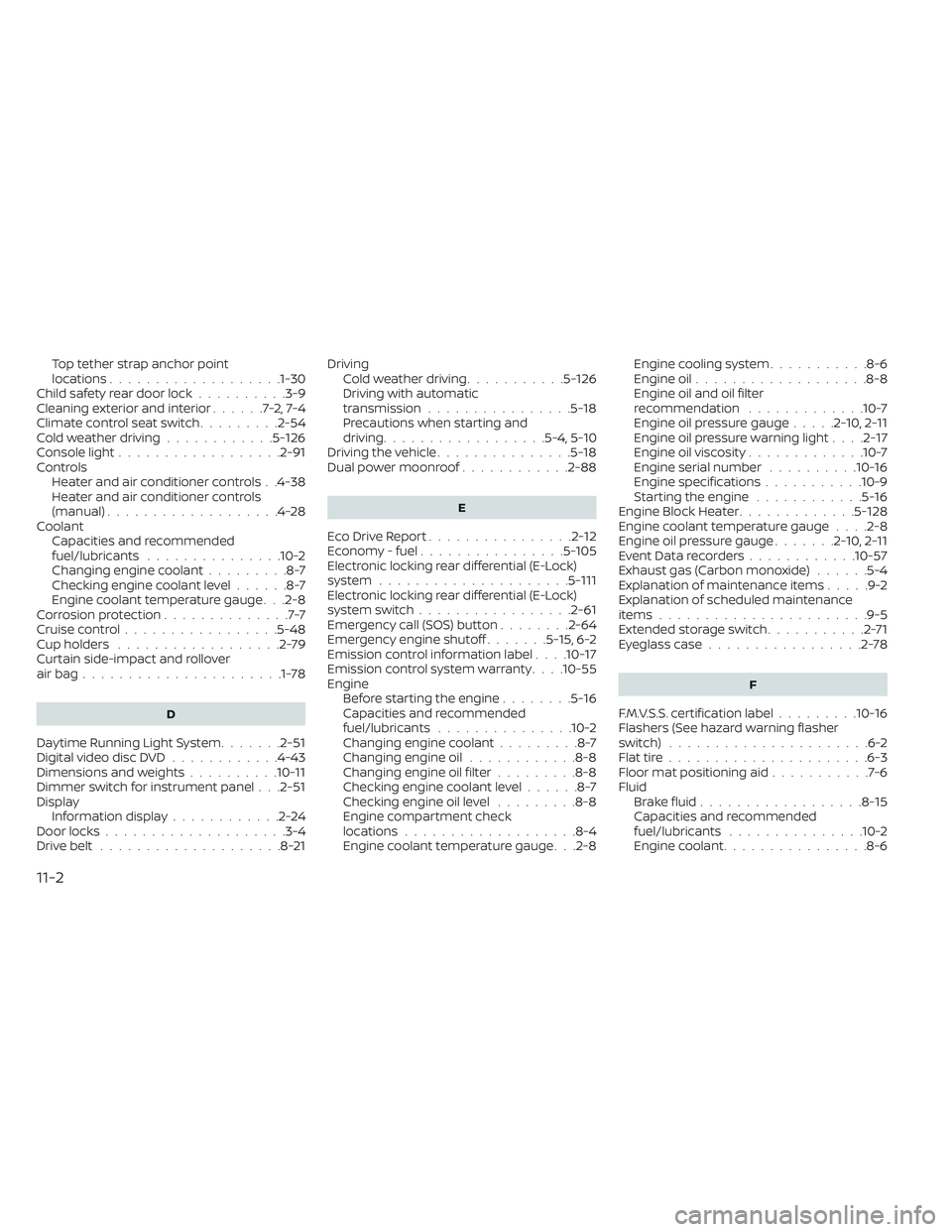
Top tether strap anchor point
locations...................1-30Child safety rear door lock..........3-9Cleaning exterior and interior......7-2,7-4Climate control seat switch.........2-54Cold weather driving............5-126Console light..................2-91Controls
Heater and air conditioner controls. .4-38Heater and air conditioner controls
(manual)...................4-28CoolantCapacities and recommended
fuel/lubricants
...............10-2Changing engine coolant.........8-7Checking engine coolant level......8-7Engine coolant temperature gauge. . .2-8Corrosion protection..............7-7Cruise control................ .5-48Cup holders..................2-79Curtain side-impact and rollover
air bag......................1-78
D
Daytime Running Light System.......2-51Digital video disc DVD............4-43Dimensions and weights..........10-11Dimmer switch for instrument panel. . .2-51Display
Information display............2-24Door locks................... .3-4Drive belt....................8-21
Driving
Cold weather driving...........5-126Driving with automatic
transmission................5-18Precautions when starting and
driving................. .5-4, 5-10Driving the vehicle...............5-18Dual power moonroof............2-88
E
Eco Drive Report................2-12Economy - fuel................5-105Electronic locking rear differential (E-Lock)
system.....................5-111Electronic locking rear differential (E-Lock)
system switch.................2-61Emergency call (SOS) button........2-64Emergency engine shutoff.......5-15,6-2Emission control information label. . . .10-17Emission control system warranty. . . .10-55Engine
Before starting the engine........5-16Capacities and recommended
fuel/lubricants...............10-2Changing engine coolant.........8-7Changing engine oil............8-8Changing engine oil filter.........8-8Checking engine coolant level......8-7Checking engine oil level.........8-8Engine compartment check
locations.................. .8-4Engine coolant temperature gauge. . .2-8
Engine cooling system...........8-6Engine oil...................8-8Engine oil and oil filter
recommendation.............10-7Engine oil pressure gauge.....2-10,2-11Engine oil pressure warning light. . . .2-17Engine oil viscosity.............10-7Engine serial number..........10-16Engine specifications...........10-9Starting the engine............5-16Engine Block Heater.............5-128Engine coolant temperature gauge. . . .2-8Engine oil pressure gauge.......2-10,2-11Event Data recorders............10-57Exhaust gas (Carbon monoxide)......5-4Explanation of maintenance items.....9-2Explanation of scheduled maintenance
items...................... .9-5Extended storage switch...........2-71Eyeglass case.................2-78
F
F.M.V.S.S. certification label.........10-16Flashers (See hazard warning flasher
switch)......................6-2Flat tire......................6-3Floor mat positioning aid...........7-6Fluid
Brake fluid..................8-15Capacities and recommended
fuel/lubricants...............10-2Engine coolant................8-6
11-2
Page 629 of 644
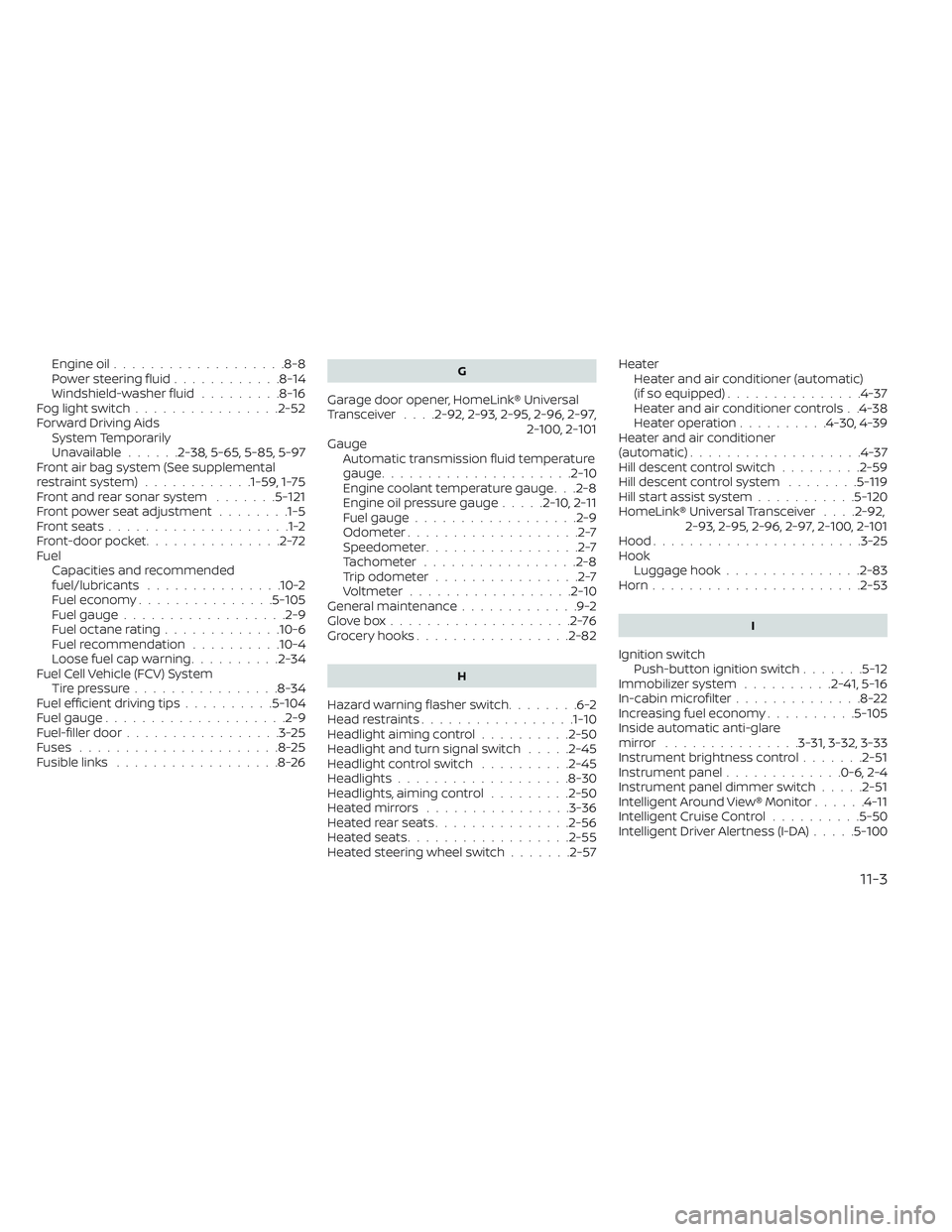
Engine oil...................8-8Power steering fluid............8-14Windshield-washer fluid.........8-16Fog light switch................2-52Forward Driving Aids
System Temporarily
Unavailable
......2-38, 5-65, 5-85, 5-97Front air bag system (See supplemental
restraint system)............1-59, 1-75Front and rear sonar system.......5-121Front power seat adjustment........1-5Front seats....................1-2Front-door pocket...............2-72FuelCapacities and recommended
fuel/lubricants
...............10-2Fuel economy...............5-105Fuel gauge................. .2-9Fuel octane rating.............10-6Fuel recommendation..........10-4Loose fuel cap warning..........2-34Fuel Cell Vehicle (FCV) System
Tire pressure................8-34Fuel efficient driving tips..........5-104Fuel gauge................... .2-9Fuel-filler door.................3-25Fuses......................8-25Fusible links..................8-26
G
Garage door opener, HomeLink® Universal
Transceiver. . . .2-92, 2-93, 2-95, 2-96, 2-97,
2-100, 2-101
GaugeAutomatic transmission fluid temperature
gauge
.....................2-10Engine coolant temperature gauge. . .2-8Engine oil pressure gauge.....2-10,2-11Fuel gauge................. .2-9Odometer...................2-7Speedometer.................2-7Tachometer.................2-8Trip odometer................2-7Voltmeter..................2-10General maintenance.............9-2Glove box....................2-76Grocery hooks.................2-82
H
Hazard warning flasher switch........6-2Head restraints.................1-10Headlight aiming control..........2-50Headlight and turn signal switch.....2-45Headlight control switch..........2-45Headlights.................. .8-30Headlights, aiming control.........2-50Heated mirrors................3-36Heated rear seats...............2-56Heated seats..................2-55Heated steering wheel switch.......2-57
Heater
Heater and air conditioner (automatic)
(if so equipped)
...............4-37Heater and air conditioner controls. .4-38Heater operation..........4-30, 4-39Heater and air conditioner
(automatic).................. .4-37Hill descent control switch.........2-59Hill descent control system........5-119Hill start assist system...........5-120HomeLink® Universal Transceiver. . . .2-92,
2-93, 2-95, 2-96, 2-97, 2-100, 2-101
Hood.......................3-25Hook Luggage hook...............2-83Horn...................... .2-53
I
Ignition switch
Push-button ignition switch.......5-12Immobilizer system..........2-41, 5-16In-cabin microfilter..............8-22Increasing fuel economy..........5-105Inside automatic anti-glare
mirror...............3-31, 3-32, 3-33Instrument brightness control.......2-51Instrument panel.............0-6, 2-4Instrument panel dimmer switch.....2-51Intelligent Around View® Monitor......4-11Intelligent Cruise Control..........5-50Intelligent Driver Alertness (I-DA).....5-100
11-3